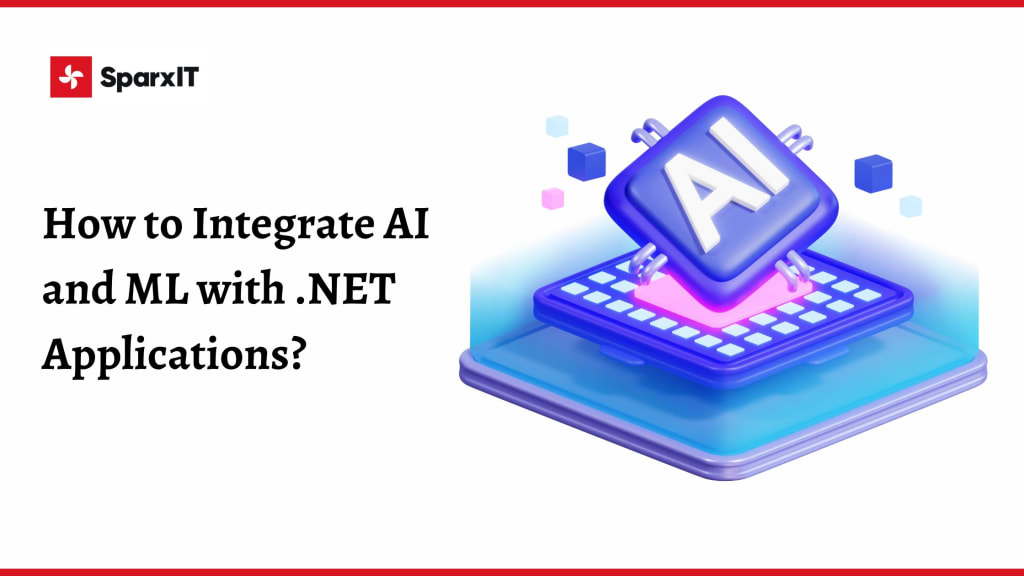How to Integrate AI and ML with .NET Applications?
AI and ML in.NET app development allows enterprises to stay updated with software development trends, benefiting both individuals and enterprises.

For almost twenty years, businesses have relied on .NET apps, which provide unparalleled performance, scalability, and security. Modern enterprises want to combine AI and ML with .NET programs to boost productivity and transform business.
Machine learning and Artificial Intelligence have evolved enormously. Modern businesses face snags that might impede their productivity and proliferation as they intervene in cutthroat business grounds. Companies are under tremendous pressure to manage enormous volumes of data and offer specialized services. Commercial processes are revolutionized, and organizational efficiency is increased by integrating AI and ML into other commercial applications. Through the deployment of ML models, AI-powered.NET applications are assisting enterprises in bridging operational gaps and adapting to changing dynamics. The choice to integrate AI and ML becomes crucial in the pursuit of a competitive edge.
This blog examines the integrate AI and ML with .NET applications.
Reasons to Enforce AI and ML in .NET Applications
Companies must look at AI and ML using the lenses of enterprise capacities, performance, and productivity. By integrating AI and ML with .NET apps, enterprises can automate and optimize workflows, personalize experiences, and gain new discernment into their data, which can help expand prolificacy and efficiency.
Here are some reasons why you must integrate AI and ML in .NET applications with the help of AI development services providers.
Process Automation
Integrating AI and ML in .NET apps allows you to seamlessly automate digital and physical tasks that are often repetitive, error-prone, and time-consuming. It will enable your employees to focus on other critical tasks and increase productivity.
Predictive Analytics
Using AI algorithms and ML models, dot NET applications can detect delicate patterns in a large chunk of data and interpret their meaning. Integrating AI and ML with .NET applications development helps businesses predict the likely action a customer or user will take. Predictive insights allow enterprises to make knowledgeable decisions and be trained for the good or bad that will happen succinctly.
Personalization
Combining AI and ML with .NET apps allows companies to personalize a user journey. It enables .NET web applications to track information about a user and their business needs, including demographics, interests, tastes, previous history, personal details, and more.
How to Integrate AI & ML Models with Your .NET Applications?
Integrating AI or machine learning with .NET applications affects several paramount stages, including:
Identifying and Defining the Use Case
Defining the project's goals and purpose is the first step to integrate AI and ML with .NET applications. With this clarity, you can decide which application is best for your .NET project: chatbots, virtual assistants, image processing, automation, decision assistance, or other features that call for machine learning or artificial intelligence.
Gathering and Arranging Information
For machine learning to be effective, diverse datasets must be used to train the algorithm. Compile and arrange large amounts of data while making sure the data is reliable, timely, and relevant for your machine learning application.
Selecting the Appropriate AI and ML Library
Choose an AI and ML framework or library compatible with .NET that meets your project's requirements. The top options for .NET developers are TensorFlow, ML.NET, PyTorch, CNTK, ONNX, and ML.NET. Ensure you have the required hardware and software before choosing to prevent any issues.
Connecting the ML/AI Model to the.NET Application
Once you have completed training and obtained the desired outputs, integrate your AI and ML models into your .NET application development. Use an appropriate API to communicate smoothly between the .NET system and the AI/ML model. Verify compatibility, functionality, and performance before deployment.
Checking and Opening the Program
Thorough testing and assessments must be carried out after the model is incorporated into the application to ensure its correctness and efficacy. Then, make the application available to your target audience so they may utilize it.
Conclusion
The app development domain is continuously unwinding, and the tools and technology in this process frequently change. Using AI and ML in .NET app development is an immaculate way for enterprises to inflate and stay up to date with the latest tendencies in software development. This connection has several benefits for both individuals and enterprises.
About the Creator
Mosche Amara
Mosche Amara is a senior web developer at SparxIT with an experience of more than six years. Apart from web development, he loves writing on the latest technologies like Blockchain, etc.
https://www.sparxitsolutions.com/






Comments (1)
Integrating healthcare with AI can be a tedious process, this blog simplifies it in real time, visit my blog as well and let me know how it is https://www.ailoitte.com/blog/how-much-does-it-cost-to-develop-a-healthcare-app/